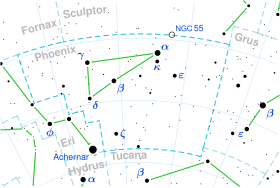Epsilon Phoenicis
| Observation data Epoch J2000 Equinox J2000 | |
|---|---|
| Constellation | Phoenix |
| Right ascension | 00h 09m 24.640s[1] |
| Declination | −45° 44′ 50.73″[1] |
| Apparent magnitude (V) | 3.87[2] |
| Characteristics | |
| Evolutionary stage | Red clump[3] |
| Spectral type | K0III[4] |
| U−B color index | +0.84[2] |
| B−V color index | +1.02[2] |
| Astrometry | |
| Radial velocity (Rv) | −9.20[5] km/s |
| Proper motion (μ) | RA: +120.393 mas/yr[1] Dec.: −179.597 mas/yr[1] |
| Parallax (π) | 22.6081 ± 0.1481 mas[1] |
| Distance | 144.3 ± 0.9 ly (44.2 ± 0.3 pc) |
| Absolute magnitude (MV) | 0.65[6] |
| Details | |
| Luminosity | 67.21[6] L☉ |
| Temperature | 4,862±42[7] K |
| Metallicity [Fe/H] | +0.00±0.08[7] dex |
| Rotational velocity (v sin i) | < 1.5[8] km/s |
| Other designations | |
| Database references | |
| SIMBAD | data |
Epsilon Phoenicis is a star in the southern constellation of Phoenix. It is visible to the naked eye with an apparent visual magnitude of 3.87.[2] The distance to this star is approximately 144 light years based on parallax measurements, but it is drifting closer with a heliocentric radial velocity of −9.2 km/s.[5]
This is an evolved giant star with a stellar classification of K0III,[4] a star that has used up its core hydrogen and has expanded. It is a red clump star, indicating that it has undergone helium flash and is currently on the core helium-fusing horizontal branch.[3] Epsilon Phoenicis is radiating 67[6] times the luminosity of the Sun from its photosphere at an effective temperature of 4,862 K.[7] Based on the elemental abundance of iron in the stellar atmosphere, the metallicity of Epsilon Phoenicis is similar to that of the Sun.[7]
References
[edit]- ^ a b c d Brown, A. G. A.; et al. (Gaia collaboration) (2021). "Gaia Early Data Release 3: Summary of the contents and survey properties". Astronomy & Astrophysics. 649: A1. arXiv:2012.01533. Bibcode:2021A&A...649A...1G. doi:10.1051/0004-6361/202039657. S2CID 227254300. (Erratum: doi:10.1051/0004-6361/202039657e). Gaia EDR3 record for this source at VizieR.
- ^ a b c d Ducati, J. R. (2002). "VizieR Online Data Catalog: Catalogue of Stellar Photometry in Johnson's 11-color system". CDS/ADC Collection of Electronic Catalogues. 2237. Bibcode:2002yCat.2237....0D.
- ^ a b Laney, C. D.; et al. (2012), "A new Large Magellanic Cloud K-band distance from precision measurements of nearby red clump stars", Monthly Notices of the Royal Astronomical Society, 419 (2): 1637, arXiv:1109.4800, Bibcode:2012MNRAS.419.1637L, doi:10.1111/j.1365-2966.2011.19826.x, S2CID 117788450.
- ^ a b Houk, N. (1978). Michigan catalogue of two-dimensional spectral types for the HD stars. Vol. 2. Dept. of Astronomy, University of Michigan. Bibcode:1978mcts.book.....H.
- ^ a b Gontcharov, G. A. (2006). "Pulkovo Compilation of Radial Velocities for 35 495 Hipparcos stars in a common system". Astronomy Letters. 32 (11): 759–771. arXiv:1606.08053. Bibcode:2006AstL...32..759G. doi:10.1134/S1063773706110065. S2CID 119231169.
- ^ a b c Anderson, E.; Francis, Ch. (2012). "XHIP: An extended hipparcos compilation". Astronomy Letters. 38 (5): 331. arXiv:1108.4971. Bibcode:2012AstL...38..331A. doi:10.1134/S1063773712050015. S2CID 119257644. Vizier catalog entry
- ^ a b c d Soubiran, C.; et al. (July 1, 2022). "Assessment of [Fe/H] determinations for FGK stars in spectroscopic surveys". Astronomy and Astrophysics. 663: A4. arXiv:2112.07545. Bibcode:2022A&A...663A...4S. doi:10.1051/0004-6361/202142409. ISSN 0004-6361.
- ^ De Medeiros, J. R.; Alves, S.; Udry, S.; Andersen, J.; Nordström, B.; Mayor, M. (2014). "A catalog of rotational and radial velocities for evolved stars". Astronomy & Astrophysics. 561: A126. arXiv:1312.3474. Bibcode:2014A&A...561A.126D. doi:10.1051/0004-6361/201220762. S2CID 54046583. Vizier catalog entry
- ^ "eps Phe". SIMBAD. Centre de données astronomiques de Strasbourg. Retrieved 2024-11-07.

